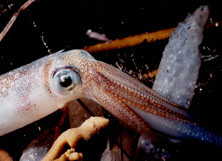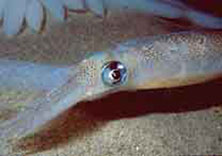Market Squid (Pacific Loligo) (Loligo opalescens)
- Population estimates are unknown. Squid have a very high natural mortality rate and the entire stock is replaced annually, even without fishing.
- The California Department of Fish and Game actively manages the market squid fishery consistent with the federal fishery management plan developed by the Pacific Fishery Management Council.
- Squid are an excellent source of selenium, riboflavin, and vitamin B12. For more on nutrition, see Nutrition Facts. (USDA)
- Most of the market squid caught in the U.S. are exported, mainly to China, the Philippines, Japan, Spain, and Venezuela.
|
 |
 |
 |
 |
| Nutrition Facts |
| Servings 1 |
| Serving Weight
100g |
 |
| Amount Per Serving |
 |
| Calories 92 |
 |
| Total Fat |
1.38 g |
 |
| Total Saturated Fatty Acids |
0.358 g |
 |
| Carbohydrate |
3.08 g |
| Sugars |
0 g |
| Total Dietary
Fiber |
0 g |
 |
| Cholesterol |
233 mg |
 |
| Selenium |
44.8 mcg |
 |
| Sodium |
44 mg |
 |
| Protein |
15.58 g |
 |
|
 |
 Market squid swim backwards by pumping water through valves near their heads. Market squid swim backwards by pumping water through valves near their heads.
|
 |
Did you know?
In the last decade, increases in catch and price have combined to make market squid the most valuable fishery in California.
In California, most squid marketed for human consumption is frozen, but minor amounts are canned or sold fresh. Demand for frozen squid in the U.S. is relatively small, so most is exported, mainly to China, the Philippines, Japan, Spain, and Venezuela.
Squid is also frozen for bait supplied to domestic commercial and recreational fishers and is an important source of live bait for the California recreational fishing industry.
Market squid are members of the mollusk family known as cephalopods, which means foot-on-head.
|
|
| |
 |
|
Market squid laying eggs. The market squid fishery is unique - fishing activity occurs directly above the spawning grounds where the females lay their eggs. Because of this, escapement of eggs before the squid are captured is key to the production of the next generation.
|
 |
|
Like most squid species, market squid have an ink sac, which serves as a defense mechanism. Squid expel ink to confuse predators.
|
|
Sustainability Status
Biomass: Unknown
Overfishing: Unknown
Overfished: Unknown
Fishing and habitat: Commercial squid fishing vessels primarily use purse seines, although scoop nets are also used in the southern California fishery. Powerful lights are often used to attract the squid to the surface where they are more easily captured. Purse seines used for squid typically do not hang as deep as purse seines used for other species, so contact with the bottom is reduced.
Bycatch: Bycatch is generally low because most vessels fish with roundhaul gear, which encircles schools of fish with nets. Squid eggs are occasionally observed in purse seines when the seines contact the bottom.
Aquaculture: There is currently no commercial aquaculture of market squid in the U.S.
|
Science and Management
Market squid were included in the Pacific Fishery Management Council's Coastal Pelagic Species Fishery Management Plan in 1999. The market squid resource is a monitored species (monitored meaning that monitoring landings and available abundance indices are considered sufficient to manage the stock). There are no mandatory harvest limits for monitored species, but other management measures such as area closures could apply to these species. Maximum sustainable yield is defined for market squid using egg escapement (the proportion of squid allowed to spawn prior to capture), as biomass estimates are not available. The California Department of Fish and Game (CDFG) has management authority over market squid, consistent with the PFMC's FMP. State provisions include a seasonal catch limitation, time and seasonal closures, monitoring programs, and a permit system.
The CDFG and the National Marine Fisheries Service, recognizing the need for better scientific information on squid, have conducted cooperative research on market squid since 1997. Read more about market squid research at NOAA's Southwest Fisheries Science Center.
|
Life History and Habitat
Life history, including information on the habitat, growth, feeding, and reproduction of a species, is important because it affects how a fishery is managed.
- Geographic range: Market squid are found from the southern tip of Baja California to southeastern Alaska, but they are most abundant between Punta Eugenio, Baja California and Monterey Bay, California.
- Habitat: Market squid are harvested near the surface and generally considered pelagic, but are actually found over the continental shelf from the surface to depths of at least 2,600 feet. They prefer the salty ocean and are rarely found in estuaries, bays, or river mouths.
- Life span: Short lived - up to 12 to 14 months.
- Food: Squid feed on copepods (small crustaceans) as juveniles. As they grow, they feed on krill and other small crustaceans, small fish, and other squid.
- Growth rate: Fast.
- Maximum size: 1 foot total length, including arms.
- Reaches reproductive maturity: Most mature and spawn when they are about 1 year old.
- Reproduction: Market squid are terminal spawners - they spawn at the end of their life span. Spawning squid concentrate in dense schools near spawning grounds. Males deposit spermatophores into the mantle cavity of females. Eggs are fertilized as they are extruded. Females produce 20 to 30 egg capsules, each capsule containing 200 to 300 eggs. Females attach each egg capsule to the substrate. As spawning continues, mounds of egg capsules covering more than 330 square feet may be formed. Spawning is continuous, and eggs of varying developmental stages may be present at one site. Eggs take several days to a few months to hatch, depending on temperature. Newly hatched squid are called "paralarvae" and resemble miniature adults. Paralarvae are dispersed by currents.
- Spawning season: Year-round. Peak spawning usually begins in southern California during fall-spring. Off central California, spawning normally begins in the spring-fall. Off Oregon, squid spawning has been observed during May to July. Spawning normally begins in late summer off Washington and Canada.
- Spawning grounds: Habitat requirements for spawning are not well understood. Spawning occurs over a wide depth range. Known spawning areas include shallow semi-protected nearshore areas with sandy or mud bottoms adjacent to submarine canyons where fishing occurs.
- Migrations: Market squid migrate throughout the eastern Pacific from the waters off southeastern Alaska to Mexico in enormous schools.
- Predators: Few organisms eat squid eggs, although bat stars and sea urchins have been observed doing so. Like other coastal pelagic species such as anchovy and sardine, market squid are probably important prey to a long list of fish, birds, and mammals including threatened, endangered, and depleted species. Some important predators of squid include king and coho salmon, lingcod, rockfish, harbor seals, California sea lion, sea otters, elephant seal, Dall's porpoise, sooty shearwater, Brandt's cormorant, rhinoceros auklet, and common murre.
- Commercial or recreational interest: Both
- Distinguishing characteristics: Market squid have eight arms and two tentacles that extend from the ends of their bodies where their mouths are present. They have a mixed, iridescent coloration of milky white and purple; however, coloring can change in response to environmental conditions.
|
Role in the Ecosystem
Market squid are critical sources of food for a wide variety of fish, birds, and marine mammals, such as king salmon, coho salmon, lingcod, rockfish, seals and sea lions, sea otters, porpoises, cormorants, and murres.
|
Additional Information
Market name: Squid
Vernacular name: Opalescent Inshore Squid
|
Biomass
Biomass refers to the amount of market squid in the ocean. Scientists cannot collect and weigh every single squid to determine biomass, so they use models to estimate it instead. These biomass estimates can help determine if a stock is being fished too heavily or if it may be able to tolerate more fishing pressure. Managers can then make appropriate changes in the regulations of the fishery.
No direct, statistically sound population estimates are available. Population dynamics of market squid are poorly understood. Annual fluctuations in catch may reflect abundance patterns, but this idea is not certain. Squid have a very high natural mortality rate and the entire stock is replaced annually, even without fishing. Thus, the health of the squid population may be dependent on successful spawning each year coupled with good survival.
Landings
 Landings refer to the amount of catch that is brought to land. The California squid fishery accounts for most of the coast wide landings. Minor amounts of market squid are landed in Canada, Washington, and Oregon. A growing international market for squid and declining squid production in other parts of the world resulted in an increased demand for California market squid. As a result, commercial landings of market squid in California more than quadrupled from 1980 to 1997. The California annual squid catch set records of 56,000 metric tons, 70,000 metric tons, and 80,000 metric tons during 1994-1996. Landings refer to the amount of catch that is brought to land. The California squid fishery accounts for most of the coast wide landings. Minor amounts of market squid are landed in Canada, Washington, and Oregon. A growing international market for squid and declining squid production in other parts of the world resulted in an increased demand for California market squid. As a result, commercial landings of market squid in California more than quadrupled from 1980 to 1997. The California annual squid catch set records of 56,000 metric tons, 70,000 metric tons, and 80,000 metric tons during 1994-1996.
Note: U.S. commercial landings are shown in the graph.
Biomass and Landings
Are landings and biomass related? Landings are dependent on biomass, management measures in the fishery, and fishing effort.
Data sources:
Landings from NMFS Annual Landings Statistics using "SQUID, CALIFORNIA MARKET" as Species and "ALL STATES" as State
|
Important Dates
Pre-1990 – California squid catches are relatively small (generally less than 20,000 tons) due to limited markets and no regulation controlling catch
Late 1990s – Market squid fishery increases briefly because of new (primarily Asian) markets and higher prices
1997 – California passes a bill closing areas north of Point Conception to squid fishing on the weekend; establishes a new squid permit with a three-year moratorium on additional permits; income generated from permits is dedicated to squid research and management; gives California Department of Fish and Game management authority
1997 – The market squid fishery is the largest and most valuable in California
1997-1998 – Squid landings decline during El Nino as they became harder to catch and markets collapse due to poor economic conditions in Asia
1999 – Market squid included in the Coastal Pelagic Species FMP
2001 – California legislature approves a bill that provides for the management of market squid by the California Fish and Game Commission and requires the adoption of a squid FMP
2004 – Market Squid Fishery Management Plan adopted by the California Fish and Game Commission
|
Notes and Links
General Information:
Pacific Fishery Management Council Backgrounder on Coastal Pelagic Species
SWFSC Market Squid Research
SWFSC Videos of Market Squid in La Jolla Canyon
California Department of Fish and Game - Market Squid Fishery Information
NMFS Sustainability Species Identification - Common market squid
NOAA National Marine Sanctuaries - Ecosystem approach to market squid harvest in California
NOAA Monterey Bay National Marine Sanctuary - Squid Management Plan Summary
Fishery Management:
Coastal Pelagic Species Fishery Management Plan
California Department of Fish and Game (CDFG)
|
| |
|



